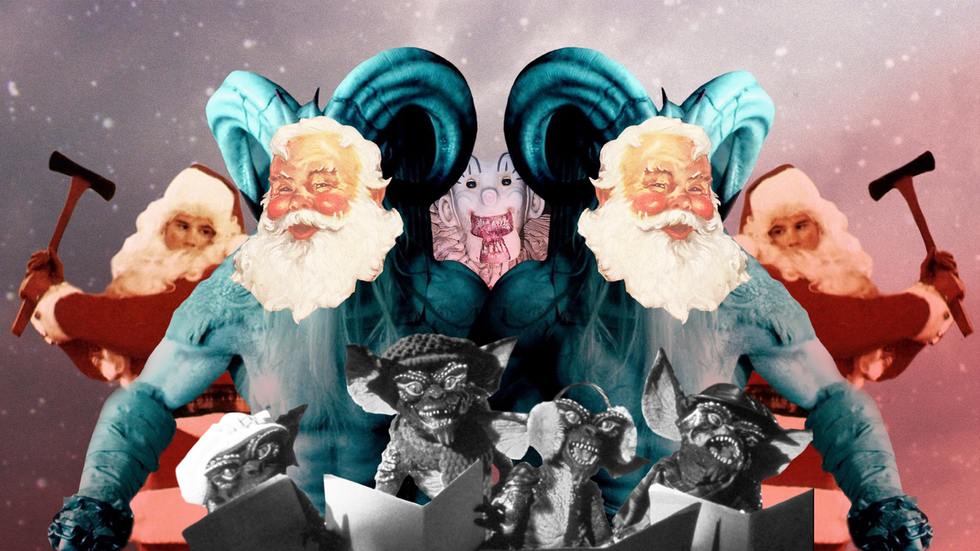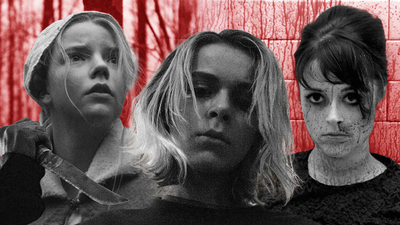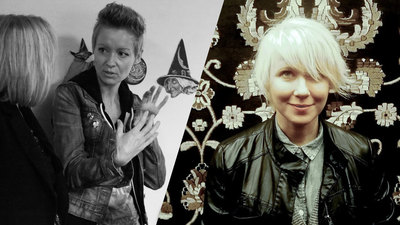
BY MATT BARONE |
Scary Claus: Exploring KRAMPUS and the Christmas Season's Serious Horror Cred
This year's holiday season officially kicks off with the release of the super-fun horror-comedy KRAMPUS, which may seem like a weird Yuletide viewing choice—that is, to those who aren't hip to Christmas' longstanding connections to all things macabre.

Horror movies set around Halloween make perfect sense—the holiday itself revolves around scares, monsters, ghosts, and every other component needed to make a quality horror flick. The best examples utilize the day's most important elements to tell their stories of darkness: The killer in John Carpenter's Halloween (1978), Michael Myers, is able to stalk the suburbs of Haddonfield in a creepy mask because everyone else's faces are similarly covered; the 1988 cult favorite Night of the Demons cleverly elevates a booze-filled Halloween party for teenagers into a cavalcade of supernatural violence; once-misunderstood, Michael-Myers-free sequel Halloween III: Season of the Witch (1982) turns children's masks into hideous killing machines; and Michael Dougherty's anthology Trick 'r Treat generates ample thrills and chills from the holiday's plethora of imagery and traditions.
At first glance, Christmas horror movies are, at least narratively speaking, a tougher sell. Which leaves the new horror-comedy Krampus, directed and co-written by Trick 'r Treat's Dougherty, in a tricky position: Are mass audiences ready to invite a creature-packed, death-laden 90-minute dose of pitch-black laughter into their holiday season? Unlike Halloween, which allows for ghoulish commercialization strategies, the holiday responsible for feel-good songs like "Jingle Bells," "Santa Claus is Coming to Town," and Mariah Carey's "All I Want for Christmas is You" is marketed through good tidings, family-tied happiness, and a mascot who’s known for giving toys to tykes. Because of that, some might chuckle at Krampus' TV spots for all the wrong reasons, but they shouldn't. Dougherty's movie could very well go down as the greatest Christmas horror movie ever for doing something that all preceding Christmas horror movies haven't: planting its genre sensibilities one-hundred percent in the actual holiday's roots.
Not that there hasn't been a fair share of great Christmas scare flicks in the past. Few genre movies are as much fun as Joe Dante's horror-comedy Gremlins (1984), a direct predecessor of Dougherty's Krampus for how it makes excellent use of the holiday's key motifs, like when the little water-powered monsters humorously sing Christmas carols. The best Christmas horror movie of them all, though, is the seminal slasher movie Black Christmas (1974), which the late writer-director Bob Clark made nine years before directing the quintessential family-friendly Xmas pic, A Christmas Story; set in a sorority house over the holiday break, where an unseen madman kills the co-eds one by one, Black Christmas paved the way for Carpenter's Halloween and boldly staged its murder sequences from a first-person POV.


Another winner can be found in the British omnibus Tales from the Crypt (1972); in the knockout segment titled "And All Through the House," Joan Collins plays a gold-digging wife who offs her husband on the same Christmas night that a lunatic dressed as Santa Claus escapes from a mental institution. And 1984's Silent Night, Deadly Night, in which the killer dresses up as Santa, hacks people up with an ax, and hangs one unlucky lady on her back by a pair of wall-mounted antlers, holds up as one of the most fascinating releases within the slasher movie craze of the early '80s, especially notable for the uproar it caused amongst parents’ groups.


The one thing those movies have in common, though, is their Yuletide-specific minimalism. “As a kid, I enjoyed all of those Christmas slasher movies, but they always lacked something,” says Dougherty. “They lacked the Christmas side of the stories. The killers could've been wearing any costume and the outcomes wouldn’t have been any different. Christmas felt more like a gimmick than a necessary storytelling device.”
To inspire himself while writing Krampus, Dougherty revisited the two most cherished Christmas movies that, on their surfaces, aren't considered horror—closer looks, however, exhibit their undeniable genre chops. "We took a page from A Christmas Carol and another page from It's a Wonderful Life," says Dougherty. "Those were two big sources of inspiration. If you really think about those two movies, they're creepy waking nightmares. In A Christmas Carol, we're talking about this broken shell of an old man who's basically terrorized by these Christmas ghosts into being a good person; they’re basically pointing a gun to his head, in essence, and saying, 'Become a good person or you'll end up like this.' And It's a Wonderful Life is very morbid, as much as it's uplifting in the end; you're talking about a movie where a guy is ready to kill himself by jumping off of a bridge until an angel comes along and says, 'You should rethink that because here's what the world would be like if you never existed.'"
Motivated by Charles Dickens and Frank Capra, Dougherty set out to give Christmas a straight-up horror movie that could hopefully stand alongside those two prestigious holiday standards. To do so, he decided to look at Christmas below its lines. "The crazy thing is," says Dougherty, "there's been so much horror material to pull from Christmas. People just haven't been looking deep enough."
For Michael Dougherty, something's always been off about Christmas. It makes perfect sense that he'd co-write and direct a Yueltide horror movie, Krampus—he's never been one to quickly embrace the holiday's universally acknowledged pleasantries.
Growing up in Columbus, Ohio, as a passionate horror movie lover and animation junkie, Dougherty satiated his illustration fixes by doodling self-created cartoon characters; during the holiday season his focus would shift towards "Santa Claws," a variation on Old Saint Nick that would, obviously, terrorize children rather than bestow gifts upon them. Dougherty took more pleasure in Halloween, the one holiday wholly dedicated to monsters and scares. That affinity for October's final day has remained intact through adulthood. While studying at New York University's Tisch School for the Arts in the mid-'90s, he wrote, directed, and handled the animation on Season's Greetings, a four-minute short about a mythological guardian of all things Halloween-sacred, named "Sam," a pint-size demon that wears a sack over its ghoulishly deformed head. Twenty-one years after the short's completion in 1996, Dougherty, by then a successful Hollywood screenwriter with X2: X-Men United and Superman Returns scripts to his name, wrote and directed the feature-length expansion of Season's Greetings: Trick 'r Treat, which stands as one of the best horror movies of the 2000s.
But Dougherty's interest in that other major and hugely marketable holiday remained. "Halloween has always been my all-time favorite holiday, to the point where November 1 is really depressing," says Dougherty, 41. "Halloween's over, the pumpkins are dead, and you're just drowning in Christmas stuff. I always thought there had to be something else underneath all of the Christmas cheer, though. It felt like Christmas was either missing something or hiding something."
Around the time when he started developing Trick 'r Treat, Dougherty dedicated time outside of his made-up Halloween-centered universe to delving into Christmas' origins. What he discovered surprised him, revealing that the late-December holiday isn't all that much different from his beloved Halloween after all: Both holidays were born through Paganism. "I started going down the rabbit hole, doing a ton of research on Christmas, and through that I found out that, just like Halloween, Christmas is based on some pretty strange Pagan customs," says Dougherty. "For example, 'Yule' used to be a celebration of the Winter Solstice, which was a Pagan thing. The same goes for a lot of the other rituals and customs that people think have been solely made for Christmas by Christianity."
The holiday's connections to Paganism, as Dougherty learned, run even deeper than that. Christmas' dark arts résumé runs long. Many religious historians who assert that if you really analyze what's in the Bible, Jesus Christ would've had to be born in the spring, not in the winter, also say that the early Christians merely adopted the December 25 birthdate of Myrtha, the Pagan sun god, for Jesus' own recognizable born day. As Myrtha's story goes, he was a god born from a rock, which led shepherds to travel from far and wide to see the newborn for themselves—which, indeed, sounds a bit like what happened with Christianity's "three Wise Men." In ancient Rome, the weeklong festival known as Saturnalia ran from December 17 through December 23 and encouraged the Romans to indulge in all kinds of debauchery; during Saturnalia, they'd "deck the halls with boughs of holly" to keep evil spirits and demons away, since Roman pagans believed that trees were sacred, going so far as to put large evergreen trees in their homes for supernatural blessings—those trees, of course, call to mind Christmas trees.
In the United Kingdom, the traditions were even more overtly horrific. England's precursor to the jolly, white-bearded fatty we know today as Santa Claus was called Father Christmas; as legend has it, he would enthusiastically partake in the debauchery with his trusty sidekick: a horned, bipedal goat that in various illustrations looks not dissimilar to occultist deity known as Baphomet. When you're able to tie this freaky bastard into what people commonly accept as "the most wonderful time of the year," you're definitely exploring some ghastly territory. "Christmas used to be very spooky, with witches, goblins, and monsters," says Dougherty. "Those kinds of things were a huge part of the holiday for a really long time, but they've been swept under the rug, sugarcoated, and turned into this bright, cheery celebration that we currently experience. That just never felt right."
The further Dougherty delved into Christmas' sinister origins, the more excited he became about the holiday's genre-centric storytelling potential. Of all the Pagan entities that Dougherty encountered through his book-reading and Internet-sleuthing, one in particular kept standing out from the pack. "All of my research into the holiday's history constantly led me back to Krampus," he says. "All roads led to Krampus—he was sort of the MC of those original Pagan celebrations."
Another way to describe Krampus would be to call him, or "it," the holiday's best-kept secret. Dating back to Germanic Paganism's folklore, from well before the dawn of Christianity, Krampus is looks and acts like Santa Claus' evil, and much uglier, twin. He's horned, has large hooves and a long tail, wears a decrepit alteration of Saint Nick's red coat, and punishes children who've either been bad or have lost the Christmas spirit while Mr. Claus hooks the better-behaved kiddies up with presents. He's the bad cop to Santa’s good one, and, until recently, he'd been neglected by the movie industry.


In 2010, Finnish filmmaker Jalmari Helander’s critically praised horror film Rare Exports: A Christmas Tale dabbled with the holiday's seedier mythology, having its characters capture an old man whom they think is Santa Claus' malevolent counterpart, though they never identify him by the K-word. There's also last year's indie A Christmas Horror Story, a raucous Tales-from-the-Crypt-like anthology featuring William Shatner introducing four segments, including one guest-starring a bodybuilder Krampus on steroids. Now with Dougherty's movie, the old Germanic creeper is having a moment. "Rare Exports was the first contemporary film to explore the deeper mysteries and original intent of the Christmas holiday," says Dougherty. "With Krampus, my co-writers [Zach Shields and Todd Casey] and I wanted to take that torch and carry it further."
To do so, they dropped Krampus into a madcap amalgamation of Christmas movies past with a tone that's pure Gremlins and laughs on par with National Lampoon's Christmas Vacation. Dougherty's protagonist, a pre-teen named Max (played by Emjay Anthony), starts off as your typical Yuletide-loving kid who can't wait to tear open his gifts, but the rest of his family doesn't share his enthusiasm. And unfortunately, he has to spend three days with them all. Max's parents, David (Adam Scott) and Sarah (Toni Collette), are bickering and near divorce; his older sister, Megan (Stefania LaVie Owen) is suddenly too cool for his kind of excitement, since she's a teenager with a boyfriend; his Uncle Howard (David Koechner) is a gun-loving brute who's a clear nod to Randy Quaid's Christmas Vacation character, "Cousin Eddie," and whose twin girls are around Max's age, aggressively tomboyish, and torment their cousin, reading his handwritten letter to Santa out-loud at the dinner table; and his crass Aunt Dorothy (Conchata Ferrell) unapologetically hates everyone.
His soul having been systematically crushed by his loved ones, Max flees to his bedroom, mirroring Macauley Culkin's actions in the Christmas-themed Home Alone, where he rips up his Santa-directed letter and professes his newfound hatred of Christmas—unknowingly inviting Krampus and his legion of bloodthirsty helpers to intervene. To deliver Krampus' scares, Dougherty and his special effects team conceived a small army of Christmas-tinged antagonists, including CGI-rendered gingerbread men who serve as Krampus' nihilistic henchmen, a Jack-In-The-Box monster with the dental hygiene of Little Shop of Horrors' human-eating plant Audrey, a demonically possessed teddy bear, and nightmarish elves donning masks you’d only find in a "Pagan's Only" Halloween store.


For the movie's comedy, on the other hand, Dougherty mined the Christmas holiday for all of its undeniable negativity. When you're a youngster, it's the most joyous time imaginable, full of toys, wrapping paper, and more toys, but when you've grown up? It can be a month-long Hell on Earth, draining finances, causing massive stress, and turning otherwise civilized people into consumerism-minded anarchists. Krampus' hilarious opening credits sequence establishes the movie's dark sense of humor perfectly, comprised of slow-motion shots of Black Friday shoppers brutalizing each other and terrified kids crying on a shopping mall Santa's lap, all set against Bing Crosby's rendition of "It's Beginning to Look A Lot Like Christmas."
It's easy to imagine the movie's title character sharpening his claws and psyching himself up as the credits' images harshly yet honestly portray what Christmas has become. "The first thing we asked ourselves was, if Krampus was going to invade a suburban setting, what would allow for that?" says Dougherty. "It would be a combination of Black Friday shopping insanity and the cynicism of adults around Christmas forcing their kid to give up on his belief of the holiday. I was really surprised that we hadn't seen a Christmas movie that really put things like the Black Friday shopping sprees under a microscope. I'm just as guilty as the next guy of watching those things on the news or on YouTube, because they're such an experience. It's really and truly humanity at its worst."
It's that grasp on the holiday's generally overlooked downsides that separates Krampus from horror's previous Christmas stories. Watching homicidal maniacs in Santa costumes hack up archetypal characters taps into gorehounds' wheelhouses, sure, but that's not very scary. Watching a centuries-old demon fatally discipline both adults and kids who've tarnished the holiday’s spirit, though? Now that's frightening, especially when Krampus' characters uncomfortably mirror the audience's real world. Think about how badly you wanted to smack someone while trudging through disastrous retail store aisles that resembled post-apocalyptic battle zones last week on Black Friday; consider the impending "When will Christmas be over?" thoughts you'll while wrapping dozens of overpriced gifts for people who'll probably forget about your generosity by mid-January—that's a "Black Christmas" for real, not what Bob Clark directed 42 years back.
The scariest part about it all? Everyone's bound to feel that way eventually. "It's such a bizarre thing to teach our kids about Santa Claus and magic and all of these other amazing and fantastical things until they're 12 and then tell them otherwise—it's really cruel, if you think about it," says Dougherty. "What we ultimately wanted to do with Krampus is to make something that's a bit more honest about what Christmas really is and also what it should be, which, in my personal opinion, is that it's meant to be a time when we slow down, we disconnect, we stop working, and we should just be spending quality time with friends and family. But that's easier said than done."
As they say, the best horror movies are rooted in reality. If Krampus teaches moviegoers, or, more importantly, these buffoons, anything, it's to thank the Pagan gods that its central monster is strictly fictional. "Considering what people these days are capable of around Christmastime," says Dougherty, "I'd imagine that Krampus would be pretty busy right now."
Krampus opens in theaters nationwide today, Friday, December 4.
NOTE: Bob Clark's Black Christmas will screen at Brooklyn's Nitehawk Cinema on Friday, December 4, and Saturday, December 5, at midnight. Buy tickets here.

